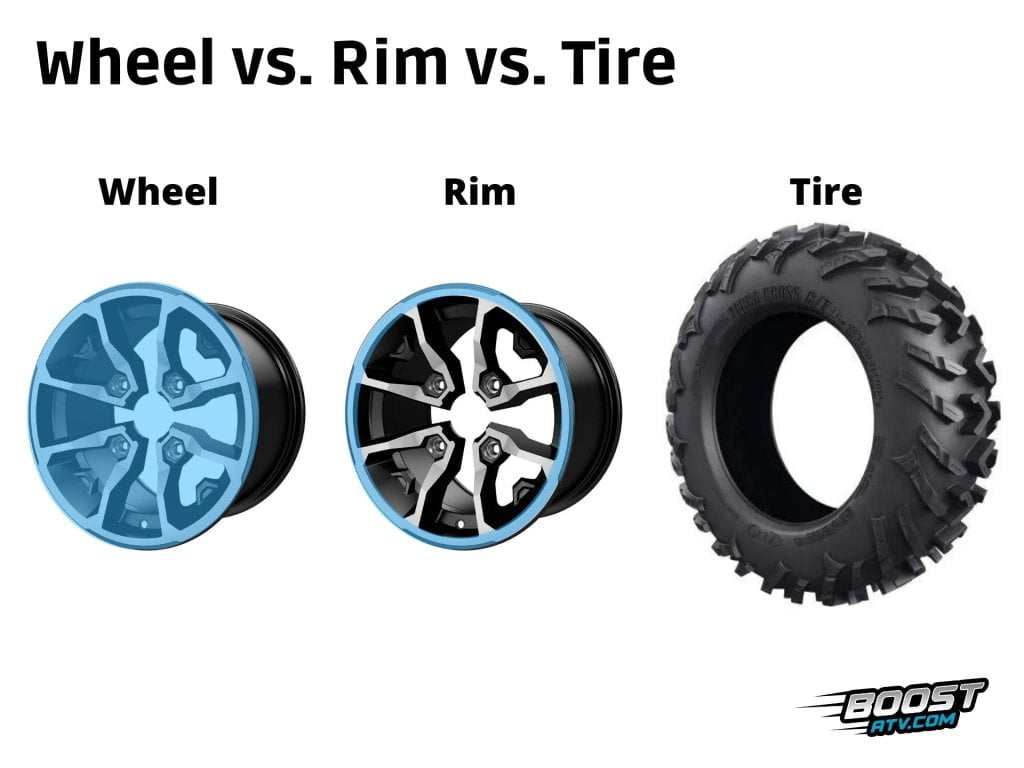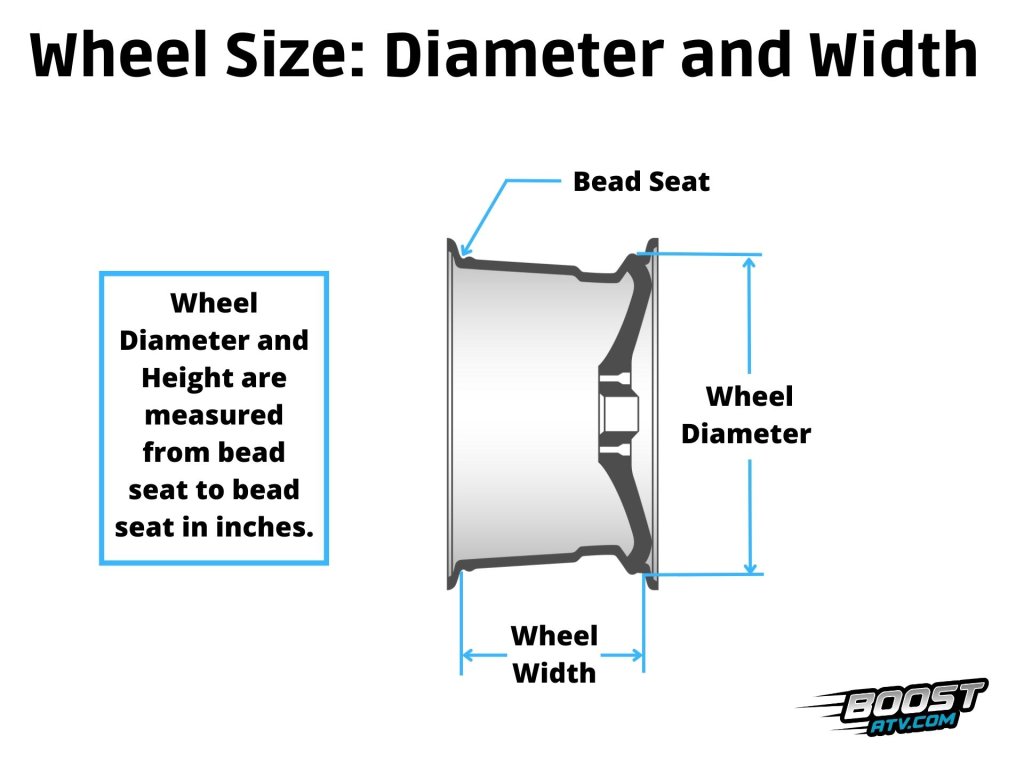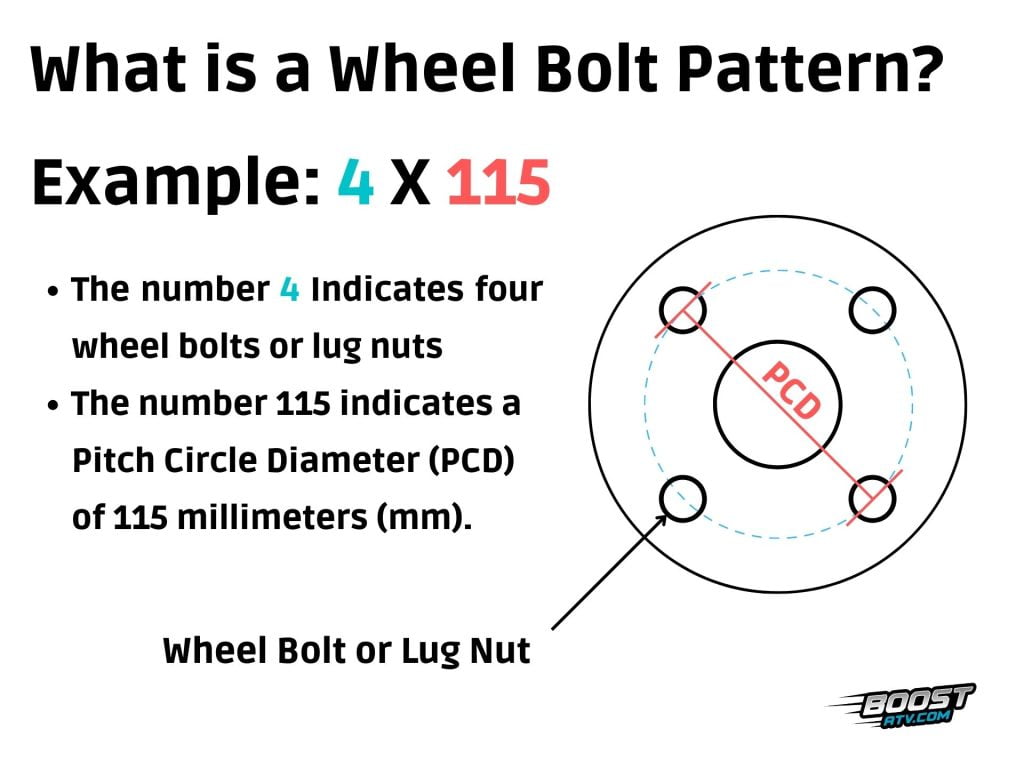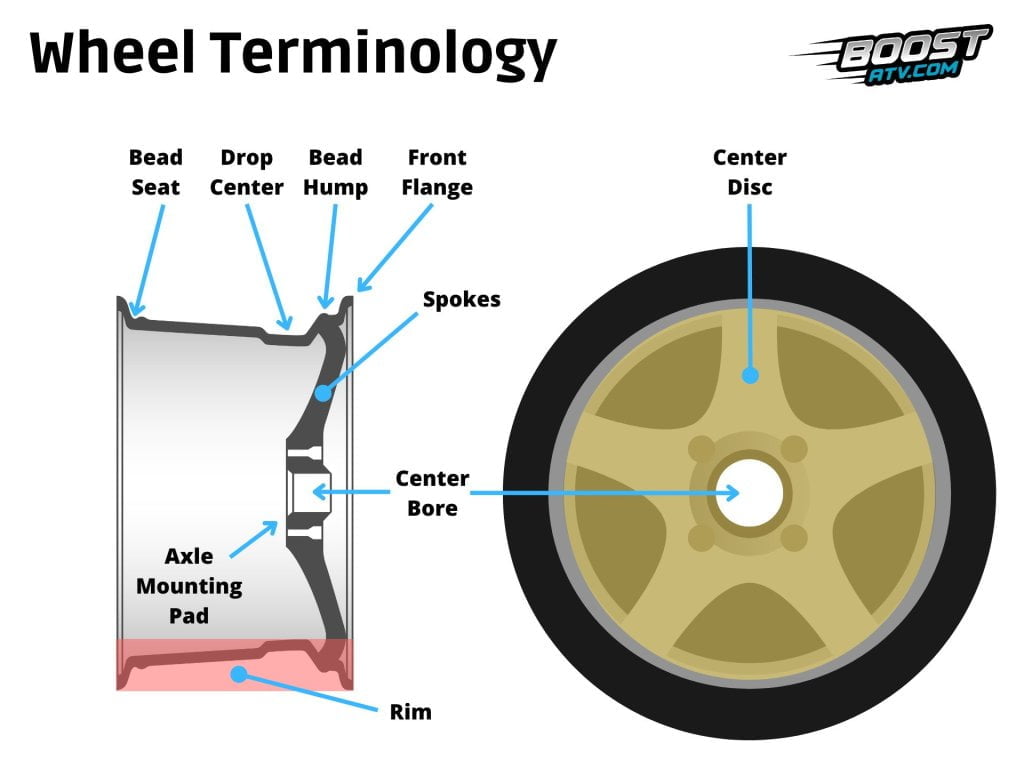The wheels and tires are one of the main things that make your ATV or UTV stand out from other vehicle types. This article answers some of the most common questions about wheels and rims when they first get into ATV and UTV riding.
Wheel vs. Rim vs. Tire
Let’s spend a few seconds on basic wheel terminology to prevent confusion.
Wheels, rims, and tires are terms that are often used as if they were interchangeable, but technically speaking, they are not.

A wheel is the entire metal unit on which the tire mounts. It consists of several structural components, including the hub, spokes, barrel, and rim.
The rim is only the outmost portion of a wheel and is everything outside the center disk.
In everyday speech, the term rim is often used interchangeably with the wheel.
The tire is the rubber that mounts onto the wheel. Its purpose is to create traction against the surface and to help cushion the ride.
A Wheel and Tire assembly or package is the complete unit of a tire mounted to a wheel.
So when people talk about getting bigger ATV rims, they are likely referring to wheels. Rims have become everyday slang for wheels, probably because it sounds better.
Also, you will rarely find someone who says wheel and tire assembly; most people say wheel or wheel and tire.
What Is an ATV Wheel?
ATV stands for All Terrain Vehicle, a four-wheeled off-road vehicle that runs on four low-pressure tires where the rider sits in a straddled operating position and steers using handlebars.
Here is a post worth checking out if you want to learn more about ATVs and what they are used for.
An ATV wheel is the metal unit the tire mounts to and can be made from steel or aluminum.
ATV wheels are similar to car wheels but are designed to run on lower air pressure and better to withstand impacts from aggressive, challenging off-road riding.
Are All ATV Wheels the Same?
While ATV wheels might look similar, there are several differences you should know.
ATV wheels are not all the same but vary in construction material, spoke design, wheel offset, size, lug pattern, and standard bead seat or bead lock design.
Let us quickly review these terms and how they differ in various ATV wheels.
Wheel Construction
Most ATV wheels are either made from steel or aluminum. Here are some of the pros and cons of each type.
Steel wheels are cheaper: Steel is cheaper, and steel wheels are more straightforward to manufacture than aluminum wheels.
Aluminum wheels are lighter: Aluminum is a more lightweight material than steel. A lighter wheel offers faster acceleration, more consistent traction in rough terrain, more responsive handling, better braking, and reduced strain on suspension and undercarriage components.
Aluminum wheels are more prone to cracking and nicks: While steel and aluminum wheels are both robust designs, the metal types have different characteristics. Steel is more flexible and will likely bend where an aluminum wheel would crack. Also, aluminum is softer and more likely to get deep scratches from sharp rocks.
Steel wheels are more prone to corrosion: Both steel and aluminum rims corrode, but steel corrosion, better known as rust, is more likely to cause bead leaks.
Manufacturing: Aluminum wheels are cast, forged, or spun, while steel wheels are welded.
Spoke design and looks: The spokes on a wheel are the part that connects the hub section with the outer drum. Steel wheels usually offer a more basic spoke design, whereas aluminum wheels offer a wide range of unique spoke designs. While some aluminum wheel designs are more rugged than others, the primary purpose of creative spoke designs is looks.
- Steel ATV wheels are more common in utility and budget models because they are cheap and rugged.
- Aluminum ATV wheels are more common in sports and recreational models because they are rugged yet lighter and typically offer a better look.
- Spun aluminum wheels are incredibly lightweight and are primarily used in dune riding applications.
Wheel Offset

One of the most common questions about ATV wheels is what wheel offset is and why it matters.
The offset on an ATV wheel is a measurement used to determine how the wheel sits in relation to the wheel hub.
The offset measurement in Power sports wheels, including ATV wheels, is usually advertised with two measurements in inches. A typical ATV wheel offset may look like this: 4+3.
- The first number is the distance from the wheel hub mounting surface to the inner bead seat.
- The second number is the distance from the wheel hub mounting surface to the outer bead seat.
- When combined, the first and second numbers equal the width of the wheel, measured between the bead seats.
The wheel offset can be negative, neutral, or positive.
- A positive offset is when the first number is bigger than the second, meaning the hub mounting surface sits outside the wheel center. A positive offset wheel sits more underneath the vehicle, giving it a narrower stance.
- Neutral or zero offset is when both offset numbers are the same (for example, 3.5+3.5). On a neutral offset wheel, the hub mounting surface sits in the center of the wheel.
- A Negative offset is when the second number is bigger than the first. A negative offset wheel sits farther out from the vehicle, giving it a wider stance.
If you want to learn about wheel offset, I recommend heading to this article, where we explain how to measure offset and why it matters.
Bead Lock vs. Standard Wheels
ATV wheels can have a standard design or a more off-road-oriented bead lock. The difference between the two designs is how the tire mounts to the wheel.
On standard wheels, the tire sits on the bead seat and is held in place by the bead hump or mounting hump and air pressure pressing the tire out against the lip of the rim.
Standard wheels are prone to come unseated in more extreme offroad riding applications where air pressure is reduced to increase traction and flotation.
On bead-lock wheels, the tire sits on the bead seat, but instead of a bead hump, it is held in place by a bead lock ring. The ring is secured by a couple of dozen bolts that pinch the wheel between the wheel flange and the locking ring.
The bead lock allows riding with low tire pressure without the tire slipping and coming unseated under hard braking, acceleration, cornering, or hitting objects.
Some wheels have bead locks on both sides, but for ATVs, it is more common with bead lock rings only on the outer edge, as this part of the wheel is typically more exposed.
Related: How Do ATV Beadlocks Work?
Wheel Sizing (Width and Diameter)

Wheel sizes are measured in Diameter X Width. While this might sound relatively straightforward, it is something many people get wrong.
You might think the width is measured from outer edge to outer edge, and the diameter is measured diagonally across the entire wheel, but that is incorrect.
The Wheel width should be measured from bead seat to bead seat, where the seat meets the flange.
The flange thickness (the edge outside the tire) on either side is not included in the advertised width. This is because wheel designs vary, and the bead-to-bead measurement better represents a reference against tire sizes.
On Beadlock wheels, you measure as if the bead lock ring wasn’t there.
The wheel diameter measures almost the same, from bead seat to bead set, but diagonally across the wheel.
The easiest way to measure the diameter is to measure the overall width and subtract the lip height twice.
If you want to learn more about ATV wheel sizing, you can head to this article.
Lug Pattern / Bolt Pattern
The lug pattern indicates how many bolt holes a wheel has and the distance between them. For instance, a 4/110 bolt pattern wheel has four holes with a diagonal spacing of 110mm.

The wheel bolt pattern must match the wheel hub, or the wheel will not fit.
Bolt patterns typically vary between ATV brands and models, so knowing your ATV’s pattern is essential.
Related: ATV Wheel Bolt Pattern and Lug Pattern Explained
ATV Wheels vs. UTV Wheels
UTV wheels are essentially the same as ATV wheels but are typically a couple of inches bigger. Also, most UTV wheels are aluminum.
What Are the Different Parts of an ATV Wheel?

A wheel comprises two units: the center disk portion and the rim portion. Each part is divided further by function. Let us begin in the middle and work our way outward.
Center Bore
The wheel’s center bore is the large hole in the center of the wheel. On hub-centric wheels, the hole is machined to fit on a protruding flange on the wheel hub. Its purpose is to help align the wheel in the center of the hub to prevent vibration.
The center bore is slightly larger on hub-centric wheels, and you’ll need to use a plastic spacer to fit the gap.
On lug-centric wheels, the center bore is machined to a generic size and doesn’t play a role in keeping the wheel centered.
A removable center cap usually covers the center bore.
Center Disc
This portion of the wheel includes the axle mounting pad area and spokes.
Axle Mounting Pad: The flat area on the rear side of the wheel’s center portion, which aligns with the wheel hub.
Wheel Spokes: The structures that connect the axle mounting pad to the outer part of the wheel are known as the barrel.
Lug Holes: The holes for lug bolts or wheel studs are usually called lug holes and are laid out according to the bolt pattern described earlier in the article.
When you draw an imaginary circle through the center of the lug holes, you get the bolt circle, also known as the Pitch Circle Diameter (PCD).
Bolt Circle. The diameter of an imaginary circle drawn through the center of each lug hole. It is also referred to as the bolt pattern.
Rim
The rim is the outmost portion of the wheel. In other words, it is everything outside the spokes.
Barrel
The barrel is the cylinder-shaped outer portion of the wheel, between the center disc and the flanges. Across the barrel, you find essential tire mounting structures such as the drop center, mounting humps, and bead seats.
Drop Center. The immersed part where the barrel diameter is the smallest. When mounting a tire to the wheel, the tire needs to go down into the drop center portion for the tire to fit onto the wheel.
Mounting Humps or bead humps: The small ridges on either side that prevents the tire from sliding away from the wheel of the edge. Seating the tire is when the tire is being installed, and air pressure forces the tire over the mounting humps.
Bead Seats: The area where the tire beads rest and seal on either side of the wheel. It is located between the mounting hump and the flange.
Valve Stem Hole: A hole in the wheel designed for inserting a valve stem that inflates the tire with air.
Flanges
The flanges are the widened outer portion of the barrel outside the bead seat. The primary purpose of the flanges is to prevent the tire from sliding off the wheel and creating seals so that air stays inside the tire.
Lip
The lip is the part of the rim outside where the spokes attach to the barrel.
What Makes ATV Wheels Different From Other Wheels?
ATV wheels are designed slightly differently than car wheels to better suit rough off-road and utility riding applications.
- The overall construction is more rugged, making it more capable of taking a beating without cracking.
- The mounting hump on ATV wheels is larger than on-road wheels to reduce the risk of unseating the tire when riding off-road at low pressure.
- ATV wheels don’t have to be as balanced, as they are not designed for high-speed on-road use.
Related: Do You, Can You, and Should You Balance ATV Tires? Best Way?
